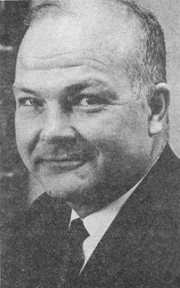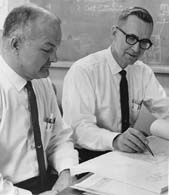Donald E. Young: Linac's Accelerator
In the truest sense of the word, Donald E. (for Edward) Young is a physicist with a mission. The respected section leader of the Linac group has many qualities-among them: Determination, Enthusiasm, Ability.
When Robert R. Wilson was named Director of the National Accelerator Laboratory early in March of 1967, he started immediately to plan for and to recruit his staff hoping to attract top people in the Midwest scientific community as well as from the east and west coasts.
Because building an accelerator, whether it be a 28, 32 or 76 BeV accelerator, is not an everyday occurrence, physicists, engineers and technicians who have had previous experience in the construction of such a scientific instrument, comprise a relatively small group of people.
In recruiting the staff to design and construct the world's largest accelerator Dr. Wilson was, naturally, interested in getting the very best men available to do the job. When it was decided that a linear accelerator would be the first injection system in the 200 BeV accelerator, the field of competent physicists was further narrowed to those who had had experience in designing and constructing a proton linear accelerator.
Donald E. Young was such a person, having worked on the design and construction of a 68 MeV proton accelerator at the University of Minnesota. "Don was the man I wanted to head the Linac Section of the National Accelerator Laboratory," said Dr. Wilson. "He was my first choice and luckily, for NAL, he accepted the invitation and the challenge." (Incidentally, Donald Young's payroll number is NAL-2.)
Illinois Background
Don is a local boy, if you want to generalize and call the Midwest "local". He was born and raised in Lake Zurich, Illinois and is a graduate of Ripon College, Ripon, Wisconsin, receiving his Bachelor of Arts degree in 1946. He started his graduate studies at the University of Chicago, but in 1948 he transferred to the University of Minnesota at Minneapolis where, as a research assistant in t h e Physics Department, he worked toward his Master's degree which he received in 1951. It was here at the University of Minnesota that he started working on the 68 MeV proton linear accelerator which was the first multi-tank proton linear accelerator, containing three tanks.
While studying for his PhD at the University of Minnesota, he was also working in the research laboratory of General Mills, Inc., on such problems as food sterilization, radiation source and computer problems. As a result of this research, he co-authored an article with Raymond Paschke and Robert W. H. Chang, entitled "Probable Role of Gramma Irradiation in Origin of Life", a most interesting and provocative subject.
Don received his Doctorate from the University of Minnesota in 1959 and continued his research with General Mills. Shortly thereafter, he joined the staff of Midwestern Universities Research Association (MURA), Madison, Wisconsin, where he worked on the 50 MeV Fixed Field Alternating Gradient Synchrotron, designed a 200 MeV proton linear accelerator, which is the type that will be used at NAL. He also contributed to the Title I study on a 200 MeV linear accelerator for the Argonne National Laboratory Zero Gradient Synchrotron (ZGS). He participated in many studies to improve the performance of the ZGS, mainly in the area of the linear accelerator injector.
In February, 1967, Don joined the staff of the University of Wisconsin at Madison, Wisconsin, as a Professor in the Nuclear Engineering Department; still working with MURA until its dissolution in July of 1967. On May 22, 1967, he came to the National Accelerator Laboratory as head of the Linac Section.
Busy Family
The Young family interests and hobbies are varied. Until recently the family numbered in the thousands including a dog, a cat, several rabbits and 10,000 bees! The bees have been given away because, according to Don, "The neighbors were a little uneasy", which is probably the understatement of the year
For many years, Bille, Don's wife, has worked with the Girl Scout organization as a leader, trainer, service unit director and, of course, as Cookie Chairman. She is looking forward to attending the National Girl Scout Convention in Seattle the latter part of this month. Both Linda, age 17 and Patricia who is 13 are active "scouters".
The young Youngs
The young man of the family, Phillip, age 11, is a Boy Scout and has started his business career in the newspaper field delivering the weekly Downers Grove Reporter.
The entire family enjoys the outdoor life with skiing a favorite winter sport and camping the summer interest. A highlight of this past summer was a four-day camping and canoe trip down the Flambeau River in Wisconsin.
Every Day New
If you ask Don what his typical daily schedule might be he will answer, "There's no such thing as a typical schedule. Every day brings new ideas that have to be worked out, new problems that have to be solved, new ways to surmount sudden obstacles; it is a constantly changing schedule and one that, because of the element of change, becomes more interesting every day".
"Achieving the 10 MeV beam on schedule has to be the most challenging aspect of the work on the linear accelerator thus far", stated Don, as he reminisced about all that went into this never-to-be-forgotten moment in the history of the NAL. Many months of planning preceded the birth of the beam.
Target Date Set
During the latter part of September, 1968, on a cold, windy day, Dr. Robert Wilson, Dr. Francis Cole and Dr. Donald Young met at a picnic table next to the Director's office to make long-range plans for the first beam. The date that was first set was September, 1969 - a year from the date of this important meeting. After much discussion, re-planning and re-plotting, they thought it might be possible to achieve a 10 MeV beam in nine months and the month of June became the target. The actual day of the month - June 26, 1969 - was chosen six weeks prior to the arrival of the beam.
Physicists, engineers, men, technicians and secretaries all worked together to achieve this goal. As Dr. Wilson stated in his talk to all NAL employees on October 1, 1969, "As the deadline came near, it got very dramatic. If you went over to the Linac Building, you saw the place just crawling with people. It was clear that they were having a rough time, so people from all parts of the Laboratory went up - secretaries were in old clothes, the AEC people were up putting wires together, and it was a very dramatic business." Many weeks before the arrival of the first proton beam, technicians worked night shifts, many employees stayed around the clock, sleeping on cots for a few hours, components were rushed to O'Hare Field to be flown to their plant of origin for further processing, flown back and installed the following day and, at the very last minute, a supply of sulphur-hexafluoride had to be found locally to replace that which had deteriorated inside the pressure vessel insulating the accelerator column.
It was a watchful and waiting time - a time when patience and understanding often times took the place of progress; but, it was an exciting time. Above all, it was a time when Donald Young was always willing to work as hard and as long as his team was working; a time when motivation was the key word and Donald Young, the motivator.
In the early morning hours of Thursday, June 26, 1969, after several false labor pains the previous weekend, at precisely 2:22 a.m., the first 10 MeV beam was born. Right on target! and, the "most happy fella" was Donald Young. No words had to be spoken as the beam appeared on the oscilloscope. The excitement and joy of the moment was reflected in his expression.
In speaking about this exciting time, Dr. Wilson expressed the feelings of the Laboratory staff when he said, ". . . happily the Linac people just came sailing through and made their schedule. They made a machine and that is something we can all really be quite proud of because they had made a very complicated machine in an extraordinarily short time and made it give protons; made it work".
On or about October 17th the Cockcroft-Walton type preaccelerator is due to arrive from Switzerland at the Port of Chicago and, hopefully, it will be put in place in the new Linac building which is nearing the end of construction and will be ready for occupancy toward the end of December. When the building is complete, the Linac group, who were the first pioneers in the NAL Village, will, once more, have the distinction of pioneering at the permanent site of the accelerator and they will be ready for their next target date which has already been set - a 200 MeV beam by February, 1971.
"This is a scary date," said Don. "It is much harder to arrive at since many things could stand in the way of achieving this type of goal; money, machinery, manpower, to name a few." At the present time, the Linac group numbers 37 people and is composed of physicists, engineers, designers, draftsmen, technicians and secretaries. Again, the Linac Section is working as a team to meet another deadline; another step, a giant one, in the building of the world's largest accelerator.
If this sounds as if it might be too much to expect; perhaps a dream - ask the man who owns one - Donald Edward Young, a man with a mission!





